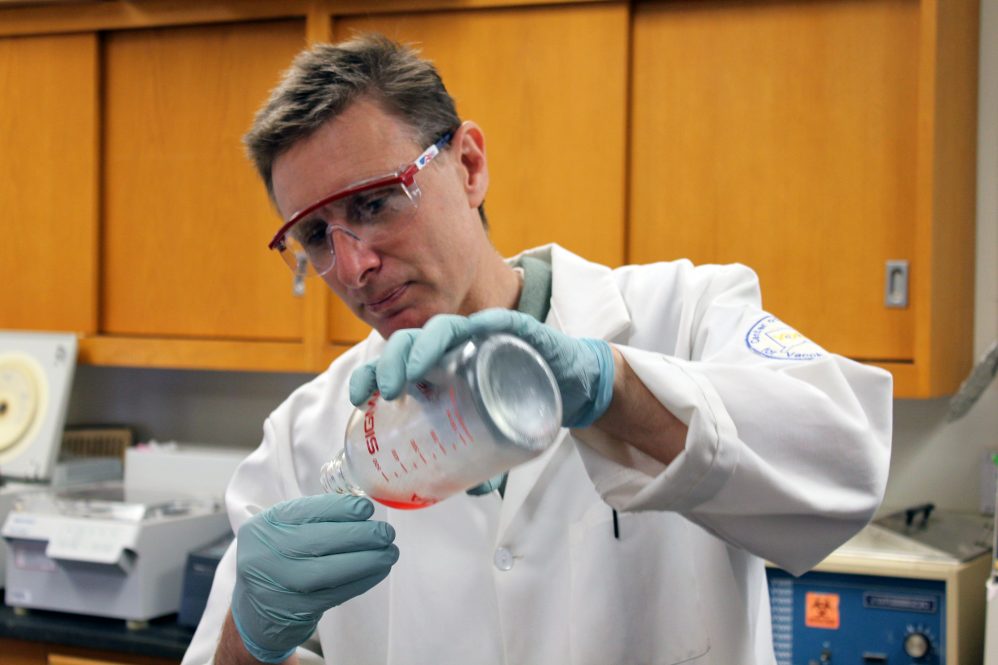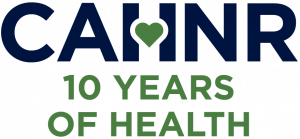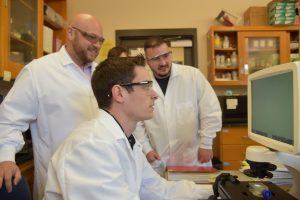In honor of World Vaccine Day and CAHNR's 10th Anniversary of Health, take a moment to learn about some of the College's contributions to ensuring public health through the development of novel vaccines and vaccine research

Edan Tulman of the Center of Excellence for Vaccine Research in the Department of Pathobiology and Veterinary Science conducts experiments in the Geary Lab in the Wilbur O. Atwater Laboratory. July 22, 2021. (Kevin Noonan/UConn Photo)
Putting the "Egg" in "Legacy"
What do chickens have to do with human health? A lot more than you might think. Many vaccines administered to humans - from flu to yellow fever to rabies - are produced using an egg-based manufacturing process. But not just any eggs will do, and the technology that makes it possible has a UConn connection.

In 1961 Roy Luginbuhl, a former professor in the Department of Animal Diseases, which would later become CAHNR's Department of Pathobiology and Veterinary Science, founded SPAFAS, Inc. SPAFAS stands for Specific Pathogen Free Avian Supplies, and the company was an early "startup" derived from a collaboration between Luginbuhl and a local poultry hatchery owner, Ray Davis. This was the first company to commercially produce eggs that were specific pathogen-free (SPF), a critical component for the development of some human and animal vaccines.
The vaccine technology developed by SPAFAS would go on to be licensed by many other companies in the decades that followed. The use of SPF eggs is now required by the FDA, USDA, and European Pharmacopeia for vaccine production.
"You really cannot overstate the importance of SPF eggs for human health," says Paulo Verardi, head of the Department of Pathobiology and Veterinary Science and professor of virology. "SPF eggs continue to be critical for research related to human and animal diseases today, as well as for the production of many vaccines currently in use like the human influenza vaccines that we get every year. It's a really important piece of UConn history that many people aren't aware of."
Center of Excellence for Vaccine Research
The Department of Pathobiology and Veterinary Science is even home to a center specifically focused on vaccine research. The Center of Excellence for Vaccine Research (CEVR) was established in 1998 and has won over $22 million in external research grants since that time. In 2019 CEVR was selected to be the nations' center for animal vaccine research coordination by the US Department of Agriculture National Institute of Food and Agriculture (NIFA). With this new funding, they created the United States Animal Vaccinology Research Coordination Network, USAVRCN.
The center's mission is to elucidate "methods of pathogenesis of, and immune responses to primary bacterial and viral pathogens with the goal of developing safe and effective vaccines," with a primary focus on diseases that affect poultry, cattle, and swine.
While much of CEVR's work focuses on animals, they have been responsible for many milestones in the development of vaccines for humans as well.

Associate professor Steven Szczepanek and Professor Steven Geary, who is also director of CEVR, along with faculty from the Department of Allied Health Sciences Larry Silbart and Jessica Malek, and former graduate students Tyler Gavitt and Arlind Mara, have worked to unlock a decades-long mystery that has hampered development of a walking pneumonia vaccine. They published findings that help explain how Mycoplasma pneumoniae (Mp), a common pathogen that causes walking pneumonia, hijacks our immune system following vaccination. The researchers are working with UConn's Technology Commercialization Services unit to patent and market their technology.
Szczepanek is also collaborating with researchers from UConn's College of Engineering and a startup company to develop a single-use, self-administered microneedle vaccine technology for infectious diseases such as COVID-19, which can be quickly distributed at home in an epidemic or pandemic to provide effective, long-term protection.
Innovations for Industry and the Public Good
Many of the research discoveries related to vaccinology in the College are of interest to pharmaceutical and biotech companies, whose R&D efforts have been increasingly outsourced to universities. While these technologies obviously have potential to garner significant profits and revenues for UConn, their value for public health is the main driver for faculty like Paulo Verardi.
Verardi has worked with companies around the world to improve vaccine production against diseases caused by flaviviruses, such as Zika, Dengue, Yellow fever, Powassan virus, and others. He has also developed a "plug and play" vaccine platform for a host of viruses and cancers. The strategy "plugs" a patient's DNA into a vector for the fast production of an effective personalized vaccine, or the genetic code of emerging viruses for the fast development of vaccines.
"UConn is deeply invested in making health and bioscience discoveries that can improve the health of people and animals," says Pamir Alpay, vice president for research, innovation, and entrepreneurship. "This type of research is a strength and priority for us, and CAHNR faculty and staff are exemplifying excellence through their work studying and developing critical vaccines."
One Planet, One Health
There's a reason the Department of Pathobiology and Veterinary Science includes a neologism. "Pathobiology" combines pathology and biology. The health of humans, animals, and our natural world is interconnected, a fact that we all learned firsthand during the COVID-19 pandemic. This concept, termed One Health by the CDC, is at the heart of the work done in the department, where there is constant overlap between research focused on animals and humans.
"It may not be immediately obvious, but our vaccine research work always has some implication for human health, even if it is primarily targeting animals and the agricultural sector," says Verardi. "We were a One Health department even before the term existed."
Steven Geary, a specialist in infectious diseases, has spent his career finding solutions to improve the health of animals in the agricultural industry. In 2008, he was selected to serve as a Jefferson Science Fellow, spending a year working at the U.S. Department of State in Washington, D.C in the Arms Control Bureau, Office of Biological Weapons Affairs. He was one of seven senior faculty from around the nation who served as scientific advisors to the diplomatic corps. Geary's knowledge of microbial diseases helped inform foreign policy to help prevent bioterrorism including events that would impact the U. S. food animal industry.
"It was a tremendous experience to see how the government operates and how agencies interact, and I would encourage this type of activity with other faculty at the University," Geary said at the time of the fellowship. "I think I provided a service to the State Department, and now people there think about UConn as a science resource."






